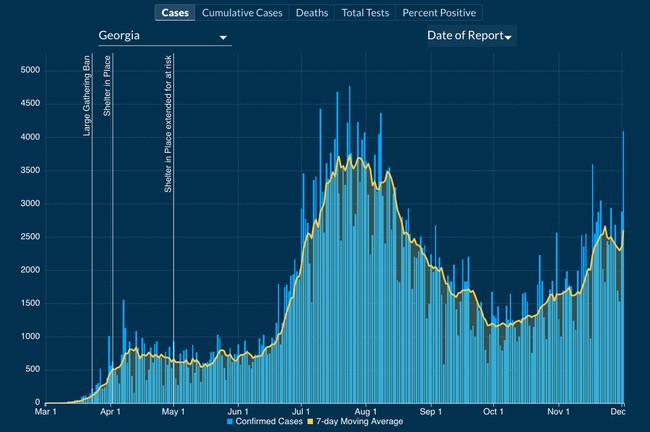OMG!!! Cancel Christmas! Look what happened on Thanksgiving!
This may be the most dishonest COVID narrative yet, other than Joe Biden saying 250,000 people will die of COVID-19 between now and January. The highest number of deaths reported in a single day was approximately 2,700. Of course, this followed a four-day holiday weekend, so the date the deaths are reported is of little consequence. But even if you take that number as fact, there were 29 days left in December when Biden asserted this. Taking a worst-case scenario approach of 2,700 deaths per day between now and January 1, 2021, that would equal 78,300 deaths.
However, the worst-case scenario is in doubt. Let’s look at data from Georgia’s COVID-19 dashboard, which honestly reports the timing of both symptom onset and death.
Here is the graph by date of death:

Here is the graph by date of report, or the day the death was entered into the system:

A few things become evident when you scroll over the data. Very few reports are entered on weekends, and the report-based curve has a lot more spikes. The curve that mirrors reality, date of death, actually appears to be declining or at least leveling off.
The graph presented using the date of death has a much smoother curve and shows the legitimate population trend. Be very wary of single-day statistics reported in the media. They may be a perversion of reality depending on how they are collected and entered. Pay attention to trends, not spikes, as the spikes likely have more to do with reporting than reality.
You see a similar trend with positive tests. Here is the data using the date of illness onset:

Here is the date of the report:

When you observe the data, you can clearly see the weekend-versus-weekday totals are different. So again, the trend is more important than the daily report number. It appears Georgia may have a small uptick in positive tests following the holiday once the data is confirmed for the date of onset. However, it will not be the wild swing that some cities and the media are reporting.
As an interesting note, the quarantine requirements from the CDC have been shortened. They now require a seven-day quarantine after a negative test and 10 days after a known exposure with no symptoms. This means the CDC knows a significant majority of people who will develop symptoms and become contagious will do so before day seven. Research shows the median from exposure to symptom onset is between five and six days. Today is seven days after Thanksgiving. If you gathered and become ill a few days from now, you were highly likely exposed elsewhere. If you are symptom-free through Sunday, December 6, it is nearly certain.
The caveat that must be presented regarding Georgia’s graphs is the state’s total experience with COVID-19. If CDC estimates for confirmed tests and the actual infection rate are accurate, as of today, 4,020,920 Georgia residents have been infected with COVID-19. That would mean that over one-third of residents act as a brake on the infection. Research is indicating that post-infection immunity response is robust and durable, quite possibly for years. A person with an effective immune response stops the transmission of the virus when they encounter it, slowing the spread.
Several studies demonstrate that exposure to other coronaviruses can provide individuals with an active immune response to COVID-19. Research has estimated that this reaction is present in 30-60% of the population, depending on the study. No one should be surprised to discover a similar immune reaction was discovered in the H1N1 pandemic. This changed assumptions about the “novel” flu by the WHO and CDC regarding how it would affect the population. To date, no assumptions have changed about the “novel” COVID-19 virus, based on similar knowledge. “Why not” is a rational question to ask.
All of this taken together indicates that Georgia may continue to see positive tests. However, because the PCR test does not identify a live, replication-competent virus, severe disease incidence due specifically to COVID-19 is likely to decline. Because of high amplification guidelines put out for these tests by the CDC, the viral debris may be found in recovered individuals and those who have a healthy immune response.
Residents in areas with lockdown enthusiasts for leaders need to demand statistics based on reality rather than reporting anomalies. They also need to insist on accurate illness severity measures, such as how many hospitalized patients were admitted for COVID-19, rather than how many patients test positive for COVID-19 upon admission and never have symptoms related to the virus.
A recent study in New Jersey showed that 89% of patients who died from COVID-19 had a do-not-resuscitate order in place before admission. These orders are most often placed when a person is given a terminal diagnosis. This goes far beyond the simple view that a risk factor for death due to COVID-19 is a comorbidity, like Type II diabetes.
All of this taken together requires the continued prohibition on gathering and crushing regulation of small businesses to be examined. Georgia is open for business, and residents are trusted to make good personal decisions because its leaders pay attention to research and data that reflects the reality on the ground. Residents of every state should demand this type of transparency from their state and local leaders. Stop being managed by panic and insist on being managed by reality.










Join the conversation as a VIP Member